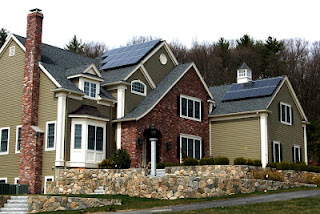
5,125 watt Sanyo array (25 x 205-watt panels)
We’ve been installing Sanyo solar panels for some time. I’ve always known they were good performers. Now I have data to prove it. Here are the results for a site we have in Eastern Massachusetts. Later I’ll publish more results from other sites.
The first site is pictured above. Just under three years ago we installed 25 Sanyo HIT power 205-watt modules for a total of 5,125 watts. The inverter for this system was a Solectria PVI-5000 string inverter. The system was wired with five strings of five modules. The combiner box was located in the home’s attic. The combined DC was run from the attic to the inverter in the basement. We also installed Solectria’s remote monitoring system “Solrenview.”

Satellite Image
The home’s orientation is within a few degrees of 180 and the array tilt is approximately 35 degrees. Using the Solar Pathfinder, I estimated that the site would perform at 98% of an ideal site because the only shade on the roof was from the roof itself (late day shade).
If you use PVWatts (for Worcester, MA), a 185 degree heading and a 35 degree tilt, the annual production is estimated for a 5.125kw array is 6,263 kilowatt-hours. Since this system went live on April 23, 2009 (within a few days of 35 months) by PVWatts estimates, this system should have produced about 17,937 kilowatt-hours (35 months at an average production of 512 kWh per month). When discounting for shade (at 98%), the total production should be 17,578 kWh.
What we’ve actually seen however, is considerably better. When we pull up the production on Solrenview, we see that the site has produced 18,655 kWh. This is approximately a 4% per year improvement over my initial estimate. (FYI, the Solrenview tends to record fewer kWh than the revenue grade meter we install next to the inverter).
The customer probably paid a 20% premium for the Sanyo system over standard mono or poly panels (I’d have to go back and dig through my contracts to verify). That 20% spread out over 20 years is a 1% per year increase in cost. However, he’s realizing a 4% or more annual improvement. I’d say he’s getting his money’s worth.
If you liked this article, you might also enjoy:





No comments yet. You should be kind and add one!
The comments are closed.